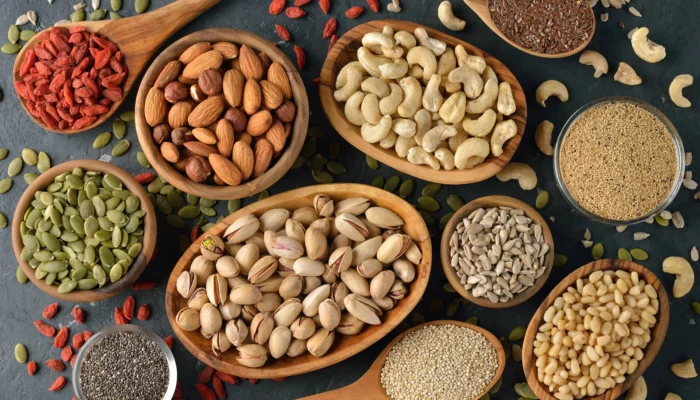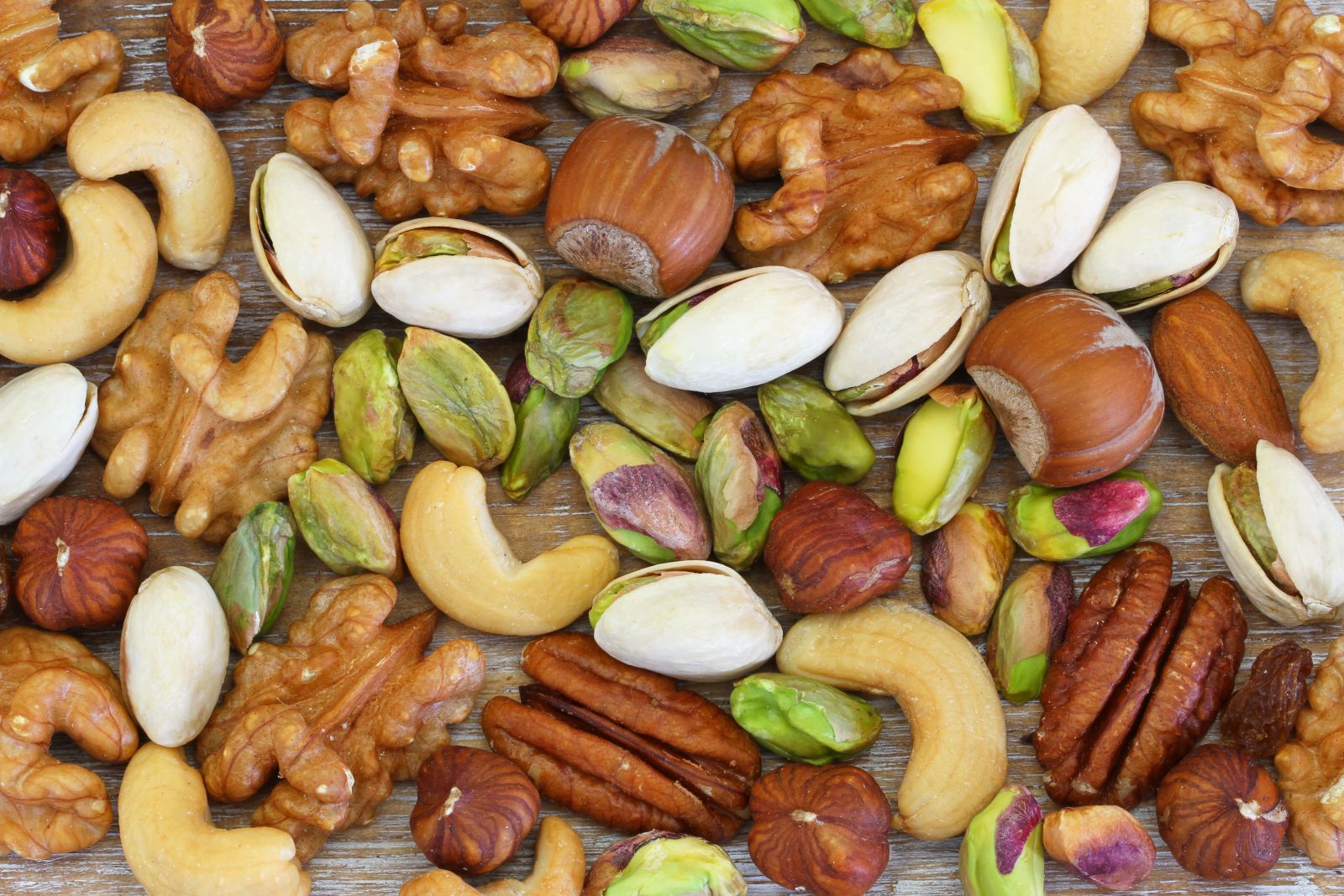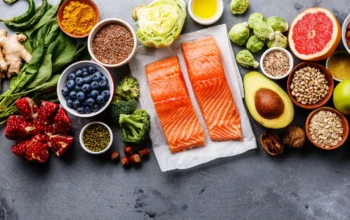Nuts: What Are They?
Nuts are seed kernels that are frequently added to food recipes or enjoyed as a snack on their own. They have a lot of calories and fat. Their hard, inedible outer shell must to be smashed open non order to reveal the kernel inside. Thankfully, the majority of nuts are available in stores already shelled and ready to consume. These are a few of the nuts that are most frequently eaten:
- Almonds
- Brazil nuts
- Hazelnuts and Cashews
- Nuts macadamia
- Pine Nuts
- Walnuts and
- Pistachios
Due to their comparable nutritional profile and traits, peanuts are commonly referred to as nuts even though they are technically legumes, like peas and beans. Nuts are high-fat, edible seed kernels with a tough shell around them. They are frequently used in cooking or consumed as a snack.

1. An Excellent Source of Numerous Nutrients
Nuts are very nutrient-dense. Contains one ounce (28 grams) of mixed nuts:
- 173 calories
- Five grams of protein
- 16 grams of fat, of which 9 grams are monounsaturated
- Six grams of carbohydrates
- 3 grams of fiber
- Vitamin E: RDA of 12%
- 16% of the RDI is magnesium.
- 13% of the RDI is phosphorus.
- 23% of the RDI is copper.
- Manganese: 26 percent of the R&D
- Of the RDI, 56% is selenium.
Certain nuts contain more of a given nutrient than others. Take selenium, for example, since one Brazil nut supplies over 100% of the Reference Daily Intake (RDI). Nuts’ carbohydrate content varies widely. Cashews provide about eight grams of digestible carbohydrates per serving, compared to less than two grams for hazelnuts, macadamia nuts, and Brazil nuts. Having said that, nuts are typically a great addition to a low-carb diet. Rich in fat and low in carbohydrates, nuts are an excellent source of vitamin E, magnesium, and selenium, among other nutrients.
2. Packed Full with Antioxidants
Nuts are a superfood for antioxidants. Free radicals are unstable chemicals that have the potential to damage cells and raise the risk of disease. Antioxidants, such as the polyphenols found in nuts, can counteract these molecules and prevent oxidative stress.
According to one study, walnuts can fend off free radicals better than fish. Studies indicate that the antioxidants included in walnuts and almonds can prevent oxidative damage to the sensitive lipids in your cells. Eating walnuts or almonds raised polyphenol levels and dramatically decreased oxidative damage in a trial including thirteen participants when compared to a control lunch.
Another study discovered that participants’ levels of oxidized “bad” LDL cholesterol, a significant risk factor for heart disease, decreased by 26–33% 2–8 hours after eating whole pecans. Walnuts and cashews, however, didn’t significantly affect antioxidant capacity in studies involving older adults and those with metabolic syndrome, even if certain other markers did improve.
Polyphenols, which are antioxidants found in nuts, may shield your cells and “bad” LDL cholesterol from oxidative damage brought on by free radicals.
3. Could Promote Loss of Weight
Despite being seen as a high-calorie food, research indicates that nuts may aid in weight loss. People who were randomized to eat almonds dropped an average of 2 inches (5 cm) from their waists, which is much more than those who were given olive oil, according to a big study evaluating the effects of the Mediterranean diet.
Controlled research have repeatedly demonstrated that almonds encourage weight loss rather than weight gain. Pistachios may also help with weight loss, according to some study. In one trial with overweight women, almond-eating participants lost almost three times as much weight and saw a markedly larger reduction in waist circumference as the control group.
Furthermore, studies reveal that although nuts contain a lot of calories, not all of them are absorbed by your body because some fat gets retained in the fibrous wall of the nut during digestion. For example, although a 1-ounce (28-gram) portion of almonds may have 160–170 calories according to the nutrition facts on the packaging, your body only absorbs approximately 129 of these calories.
In a similar vein, recent research discovered that compared to earlier findings, your body absorbs roughly 21% and 5% less calories from walnuts and pistachios, respectively. Studies have demonstrated that nuts encourage weight loss as opposed to causing weight gain. Numerous studies show that not all of the calories in nuts are absorbed by your body.
4. May Reduce Triglycerides and Cholesterol
Nuts significantly lower triglyceride and cholesterol levels. It has been demonstrated that pistachios reduce triglycerides in obese and diabetic individuals. Pistachio eaters in a 12-week trial of obese individuals had triglyceride levels that were about 33% lower than those of the control group.
Nuts may have a high monounsaturated and polyunsaturated fatty acid content, which lowers cholesterol. It seems that while hazelnuts and almonds lower total and “bad” LDL cholesterol, they increase “good” HDL cholesterol. According to one study, hazelnuts—whole, sliced, or ground—all reduced cholesterol in a similar way.
Eating a 1-ounce (30-gram) combination of walnuts, peanuts, and pine nuts daily for six weeks dramatically reduced all forms of cholesterol, with the exception of “good” HDL, according to another study conducted on women with metabolic syndrome.
Studies have demonstrated that macadamia nuts also reduce cholesterol. In a trial, the amount of cholesterol lowered by a moderate-fat diet that included macadamia nuts was equal to that of a lower-fat diet. Nuts may increase levels of “good” HDL cholesterol while lowering total and “bad” LDL cholesterol, triglycerides, and cholesterol.
5. Helpful for Metabolic Syndrome and Type 2 Diabetes
A frequent disease that affects hundreds of millions of individuals globally is type 2 diabetes. A collection of risk factors known as metabolic syndrome can raise your chance of heart disease, stroke, and type 2 diabetes. Thus, there is a high correlation between metabolic syndrome and type 2 diabetes. It’s interesting to note that nuts might be among the healthiest foods for those who have type 2 diabetes and metabolic syndrome. They don’t significantly raise blood sugar levels and are low in carbohydrates.
Therefore, reducing blood sugar levels should result from replacing higher-carb items with nuts. Research indicates that in individuals with diabetes and metabolic syndrome, nut consumption may also reduce blood pressure, oxidative stress, and other health indicators. In a 12-week randomized trial, individuals with metabolic syndrome who consumed little less than one ounce (25 grams) of pistachios twice day saw an average 9% reduction in fasting blood sugar.
Furthermore, the pistachio group experienced higher drops in blood pressure and C-reactive protein (CRP), an inflammatory marker associated with heart disease, than the control group. Nonetheless, the data is conflicting, and not all research mentions the advantages of nut consumption for those who have metabolic syndrome.
Numerous studies have demonstrated that including nuts in the diet helps persons with type 2 diabetes and metabolic syndrome improve their blood pressure, blood sugar, and other health markers.
6. Could Diminish Inflammation
Nuts are powerful anti-inflammatory foods. Your body uses inflammation as a defense mechanism against wounds, bacteria, and other potentially dangerous invaders. On the other hand, prolonged, persistent inflammation raises the risk of disease and can harm organs. Eating nuts may help to promote healthy aging and minimize inflammation, according to research.
In one study on the Mediterranean diet, individuals who added nuts to their diets saw a reduction in the inflammatory markers C-reactive protein (CRP) by 35% and interleukin 6 (IL-6) by 90%, respectively (40). Comparably, it has been discovered that several nuts, such as pistachios, Brazil nuts, walnuts, and almonds, can reduce inflammation in both healthy individuals and those suffering from serious illnesses like renal and diabetes.
However, there was minimal difference between the almond and control groups in one investigation on the consumption of almonds in healthy individuals, despite the fact that those who ate almonds had lower levels of a few inflammatory markers (45).
Empirical evidence indicates that nuts may mitigate inflammation, particularly in those with diabetes, kidney disease, and other grave medical disorders.
7. Rich in Fiber That Is Beneficial
Numerous health advantages are associated with fiber. The bacteria in your colon may break down fiber, even though your body isn’t able to. Numerous forms of fiber serve as nourishment for your beneficial gut flora or as prebiotics. The fiber is subsequently fermented by your gut flora, producing healthy short-chain fatty acids (SCFAs). These SCFAs have many advantages, such as lowering the risk of obesity and diabetes and enhancing gut health.
Moreover, fiber decreases the quantity of calories you take in from meals and increases feelings of fullness. Up to 130 fewer calories may be absorbed if fiber consumption is increased from 18 to 36 grams per day, according to one study. The following nuts have the most fiber per 1-ounce (28-gram) serving:
- 3.5 grams of almonds
- Grams of Pistachios: 2.9
- 2.9 grams of hazelnuts
- 2.9 grams of pecans
- 2.6 grams of peanuts
- Grams of macadamias: 2.4
- 2.1 grams of Brazil nuts
A lot of nuts are high in fiber, which lowers the risk of disease, aids in feeling full, slows down the absorption of calories, and enhances gut health.
8. May Lower Your Chances of Strokes and Heart Attacks
Nuts are incredibly beneficial to your heart. Due to their benefits for inflammation, arterial function, cholesterol levels, and the size of “bad” LDL particles, nuts may help reduce the risk of heart disease and stroke, according to several studies. Research indicates that the risk of heart disease may be higher for small, dense LDL particles than for bigger LDL particles.
It’s interesting to note that a study on the Mediterranean diet discovered that eating nuts significantly increased levels of “good” HDL cholesterol and significantly decreased tiny LDL particles. In a different trial, participants with normal or high cholesterol were randomized to eat a high-fat dinner with either nuts or olive oil. Regardless of their starting cholesterol levels, those in the nut group had lower fasting triglycerides and improved arterial function than those in the olive oil group.
Eating nuts can dramatically reduce your risk of stroke and heart attack. Eating nuts has several advantages, including improving arterial function, raising “good” HDL cholesterol, and increasing the size of “bad” LDL particles.
Tasty, Adaptable, and Easily Acquired
Nuts can be eaten raw, processed into nut butters, or finely chopped and added to meals. They are widely accessible in a multitude of varieties, including salted, unsalted, seasoned, plain, raw, or roasted, and may be found in grocery shops and online. Nuts are generally best eaten raw or toasted at a temperature of no more than 350°F (175°C) in the oven.
The next best thing is dry-roasted nuts, but steer clear of nuts that have been roasted in vegetable or seed oils. Because they can be stored at room temperature, nuts are perfect for traveling and as on-the-go snacks. On the other hand, a refrigerator or freezer will keep them fresher if you plan to store them for an extended period of time.
Nuts can be eaten raw, in nut butter form, or diced and added to cuisine. Rounded or uncooked are the healthiest options. To keep them fresher for longer, store them in the refrigerator or freezer or store them at room temperature.
The Final Word
Regular consumption of nuts can lower your chances of diabetes, heart disease, high cholesterol, and triglycerides, among other health problems. In spite of its high calorie content, this wholesome, high-fiber dessert may even help with weight loss. Nuts are a delicious complement to a nutritious, well-balanced diet as long as you eat them in moderation.










